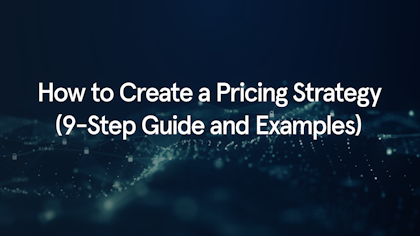A Go-To-Market (GTM) strategy is a comprehensive plan that outlines the steps required to successfully launch a new product or expand your business into new markets. It ensures that your product targets the right customer segments with the right messaging through the right channels at the right time.
In this guide, written by ex-McKinsey and Bain consultants, you'll learn how to craft a go-to-market strategy. We will also cover how a solid go-to-market template can help structure and communicate your analysis and recommendations.
What is a go-to-market strategy?
Customers, not markets, buy your products, so it's critical that you provide the right offers at the right price and time to the right customers through the most effective channels.
A go-to-market (GTM) strategy outlines precisely this. It's a comprehensive plan describing how to launch a new product or introduce an existing product into a new market. This strategy is essential for ensuring the successful rollout of your product by addressing four key questions:
- What markets do you want to pursue, and what do the market attractiveness and competition look like in those?
- Who is your target customer?
- Why should your target customer choose our product?
- How will you reach your target customers?
Launching a product requires a significant investment, but even the most innovative product can fail without the right plan. McKinsey's research shows that for every successful attempt, about four fail. These failures aren't limited to inexperienced startups. Even large, sophisticated corporations and experienced entrepreneurs often struggle when entering new markets.
A comprehensive go-to-market (GTM) strategy helps businesses avoid costly missteps, such as targeting the wrong customer segments or entering a market flooded with similar products.
When Peloton first ventured into the competitive US home fitness market, exercise bikes were far from an exciting product category. But the brand had a trick up its sleeve—instead of competing on gym floors and going through established fitness retailers, it went straight to where high-end consumers shop.
In late 2013, Peloton opened its first store in a New Jersey luxury mall. Retail stores, especially in high-end shopping malls, have been a central strategic pillar for Peloton ever since.
Even though most Peloton customers buy their bikes online, the retail stores play a vital role in the company's go-to-market strategy. They provide visibility and top-of-funnel awareness and help customers in the mid-funnel consideration phase ("I've been thinking of buying one, but I want to see it in person and try it out first.").
Peloton went from a scrappy startup to a multi-billion-dollar public company in less than eight years, thanks to an innovative product and a bold and well-planned go-to-market strategy.
When do you need a go-to-market strategy?
You need a go-to-market strategy whenever you introduce a product or service into the market.
A few examples:
- An established brand introducing a new product line in its current market (Example: A well-known beverage brand is debuting a new energy drink)
- A company expanding its existing product to new markets (Example: A local chain of hardware stores expanding to a new state)
- A business testing a novel product in a fresh market (Example: Peloton launching in the US)
Go-to-market strategy vs. marketing plan
A go-to-market strategy and a marketing plan are both crucial components of a business's overall approach to reaching its customers, but they serve different purposes.
The go-to-market strategy is a specific plan for launching a product or entering a new market. It's tailored to a particular launch and focuses on product positioning, pricing, and initial customer acquisition, addressing unique market challenges or opportunities.
In contrast, a marketing plan is a long-term, ongoing strategy to achieve overall marketing goals. It's broader, involving advertising, social media, and loyalty programs, not confined to single product launches. It aims to build and maintain brand presence and customer loyalty.
While a GTM strategy is short-term and launch-specific, a marketing plan is a comprehensive, long-term approach encompassing various marketing activities. The go-to-market strategy is a focused component of the broader marketing plan, each serving distinct but complementary roles in a business's market strategy.
Go-to-market strategy framework
The following framework, adapted from Bain's go-to-market system, outlines the main elements that should go into your go-to-market strategy.
Your existing business unit strategy is the starting point for your go-to-market strategy. From here, the go-to-market strategy framework consists of three main parts:
- Analyze: Define and understand the market where you plan to offer your products or services. Map the customer journey and identify the most attractive customer segments and their needs.
- Design: Select your target segment and design a differentially better value proposition.
- Deliver: Optimize sales, marketing, pricing, and distribution channels to serve and acquire target customers.
Go-to-market strategy template
Every GTM strategy involves lots of moving pieces, whether you're launching a new product or exploring new markets. A great go-to-market strategy requires both the right content and structure. Basing your plan on a proven framework and presentation template can accelerate the process, help maintain the proper structure, and offer ideas for designing and organizing various slide types.
Our PowerPoint go-to-market Template follows the approach discussed here. It features 217 template PowerPoint slides designed by former McKinsey, Bain, and BCG consultants. Additionally, it includes three examples of what an effective real-life go-to-market strategy can look like.
8 steps to crafting your go-to-market strategy
How do you turn the go-to-market framework above into a comprehensive strategy?
Let's go through the process step-by-step:
Step 1: Understand Business Objectives
Aligning your GTM strategy with the overall business strategy and objectives is crucial for ensuring your new product or market expansion supports your organization's broader goals and resource constraints.
Keep the following key questions in mind when developing your GTM strategy:
- How does this GTM strategy directly support our primary business objectives (e.g., revenue growth, market share increase, diversification)?
- Does this strategy align with our company's vision, mission, and core competencies?
- What resources (financial, human, technological) will this strategy require, and do we have them available?
- What are this strategy's potential risks, and how do they align with our company's risk tolerance?
Step 2. Segment your market
The key to your go-to-market strategy is knowing who to sell to. To answer this question, you need to identify customer segments that you can differentially serve and derive value from.
Customer segmentation is the act of grouping your target market into segments based on similar traits, needs, and/or behavior patterns.
B2B and B2C markets have different characteristics, needs, and decision-making processes. Therefore, they require different approaches to segmentation.
Here are a few common approaches to B2B and B2C segmentation:
B2B Segmentation:
- Firmographic: Groups customers by shared company characteristics (industry, size, revenue, location, employee count).
- Needs-based: Segments customers according to specific needs, challenges, desired outcomes, or business priorities.
- Technographic: Categorizes customers based on their technology usage and adoption patterns.
B2C Segmentation:
- Demographic: Segments consumers by shared variables (age, gender, income, education, marital status, occupation).
- Psychographic: Categories based on psychological characteristics (personality traits, values, attitudes, interests, lifestyles).
- Behavioral: Groups consumers by observed behaviors and interactions with products, services, or brands (purchase patterns, usage frequency, brand loyalty, channel preferences, benefits sought).
Step 3: Research Competition and Demand
Before you can tailor your product's value proposition and select a target audience, you need to understand the market and the competition.
Guide your analysis with these questions:
- Who already offers a similar product?
- What customer segments and regions do your competitors target?
- How does your product differ, and what unique value do you offer?
- Is there demand, or is the market oversaturated?
Conduct a competitive market analysis to identify direct and indirect competitors, and understand their strengths and weaknesses compared to your own.
Step 4: Decide on target segment and value proposition
Combine your market segmentation and your competitive market analysis and select the target segments you want to go after.
Consider factors such as segment size, growth potential, willingness to pay, competition, customer needs, and pain points, your product's unique strengths, and the segment's alignment with your overall business goals and resources.
The next step is to design the differentiated messages you'll convey to your target customers — your so-called 'value proposition'.
While a value proposition may seem straightforward, an effective one is intricate and nuanced. It addresses several key questions:
- What makes your offering superior to competitors'?
- What unique benefits can you provide?
- How can you address the target customer's specific needs?
Think about the unique benefit that you are providing. If you can define this simply, concisely, and accurately, you have a value proposition of worth to your audience.
Remember, a value proposition isn't a broad positioning statement aimed at mass appeal. The goal is not to appeal to everyone, but to be the perfect solution for your target audience.
Consider this scenario: A business seeks software with comprehensive customer support due to its limited experience with the product. A software company that emphasizes its top-rated customer service team and affordable, extensive support options—features its competitors lack—is likely to attract such businesses.
Let's look at another example: Uber – a travel service provider that meets low-cost and on-demand needs. Immediacy, affordability, and simplicity are at the heart of their value proposition.
Step 5: Map the customer journey
Now that you've identified your target segment and messaging, you can move on to mapping the customer journey—the path your target segment customers take from realizing their problem to considering your product as a solution and deciding to purchase.
Often, the customer journey is visualized as a funnel with three distinct stages:
- Top of Funnel (Awareness): Customers recognize the problem and begin researching solutions. They may not yet be aware of your product. Your goal is to capture customer attention and introduce your product as a potential solution.
- Middle of Funnel (Consideration): Customers compare your product against other available options. Demonstrate why your product is the best choice.
- Bottom of Funnel (Decision): Customers make their final purchase decision. Your goal during this stage is to convince potential buyers to commit to your product.
Understanding this journey allows you to tailor your marketing and sales efforts to effectively guide customers through each stage, increasing the likelihood of conversion.
Step 6: Choose your sales strategy
Most companies combine marketing and sales strategies when designing the go-to-market strategy that will best serve them.
However, if we were to generalize it, there are four go-to-market sales strategies: self-service, inside sales, field sales, and channel model — each one catering to a different product and business model.
Let's break them down:
- Self-service model: Customers purchase your product on their own, typically online, with minimal direct interaction with sales representatives. This is a common sales process for e-commerce, in which customers can find and buy products online. While this option doesn't require a dedicated sales team, you need to invest in marketing to drive traffic to your website. This model is commonly used for low-cost products, simple services, or products with high brand awareness (Examples: E-commerce platforms, SaaS products with freemium models).
- Inside sales model: Marketing brings the customer into the funnel. Customers might then request more info, start a trial, use a free version, or add their contact info for a piece of gated content. Sales reaches out to leads from there. This model is commonly used for higher-value products or services that require some explanation but not in-person demonstrations (Examples: B2B software sales, subscription-based services).
- Field sales model: Sales representatives travel to meet clients in person and guide them down the sales funnel. This model is commonly used for complex, high-value products or services that require in-depth explanations or demonstrations (Examples: Enterprise software solutions, industrial equipment, consulting contracts).
- Channel Model: Utilizes third-party partners or resellers to sell products or services. Leverages existing relationships and networks of channel partners. This model is commonly used for products that benefit from wide distribution or local market expertise (Examples: Consumer electronics sold through retailers, software sold through value-added resellers).
Step 7: Select marketing channels
Marketing channels are the platforms you use to generate demand for your product and guide potential customers through the funnel, from awareness to decision. Your channel selection should be based on your target audience and their stage in the buyer's journey.
Different channels are effective for various stages of the customer journey. For instance, SEO content and PR can increase brand visibility among top-of-funnel customers, while case studies and webinars engage middle-funnel prospects. At the bottom of the funnel, offering free trials can help convert potential customers.
It's crucial to align your marketing channels with where your ideal customers consume content. For example, younger consumers might prefer YouTube and TikTok over Facebook or LinkedIn. This alignment ensures your message reaches the right audience through their preferred platforms.
When selecting channels, consider whether your audience is more responsive to outbound tactics like direct mail or inbound strategies such as social media, SEO, or AdWords. This decision depends on your primary goal: generating broad brand awareness or engaging potential customers who are already interested in your offerings.
Step 8: Design your pricing strategy
A pricing strategy is a systematic approach to setting the price of your product or service, considering factors like costs, competition, customer value perception, and your business objectives (growth vs. profitability).
There is no one-size-fits-all solution for pricing strategies. To choose the best strategy for your product and GTM strategy, consider these factors:
- Cost-plus pricing This straightforward method involves adding a fixed percentage (markup) to your production costs to cover overhead expenses and ensure a profit margin. While simple to implement, it may not always align with market demand or customer value perception.
- Value-based pricing This strategy sets prices based on customers' perceived value. It requires thorough research into customer needs, pain points, and willingness to pay. This approach can lead to higher profits if your product offers unique value, but it requires ongoing market research and customer insight.
- Competitor-based pricing Here, prices are set in relation to similar products in the market. You can position your offering at a premium, at parity, or at a discount, depending on your business objectives and target audience. This strategy keeps you competitive but may limit your ability to set prices based on your product's unique value.
- Penetration pricing This strategy involves setting an initially low price to attract customers and gain market share quickly. The plan is to raise prices once you've established a strong market presence. While effective for rapid growth, it can be challenging to increase prices later without losing customers.
Your chosen strategy should align with your overall business goals and the market conditions. It's often beneficial to combine elements from different strategies to create an approach that best suits your specific situation.
You can read more on pricing strategy in our blog post "Key components of a best-practice pricing strategy".
Ready, set, strategize
Crafting a robust go-to-market strategy is essential before introducing your new product to the market. We hope the steps outlined in this guide provide a foundation for launching a product or service that addresses your target customers' needs and achieves profitability.




















